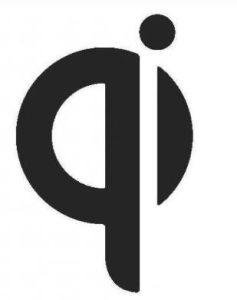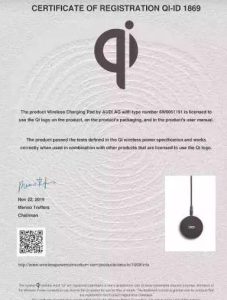How to identify Qi certified products
The WPC Wireless Charging Consortium can provide Qi certification for wireless charging products, and Qi certified products are required to pass a series of compliance and interoperability tests. These tests verify that all mandatory safety features are implemented, and that all Qi-certified wireless power transmitters (such as chargers) and receivers (such as cell phones) are compatible with each other.
Method 1: Identify according to the Qi logo.

The Qi logo applies only to Qi-certified products. It’s the WPC Wireless Charging Consortium registered trademark in most countries and regions. Using this logo requires a trademark license. Products containing the Qi logo indicate that they are Qi-certified.
This is an easy way for consumers to identify a product, but it is not always safe and secure, because manufacturers may print a fake Qi logo on their products without being Qi certified.
Only if a product is registered in the Qi Certified Products Database successfully, will allow to use the Qi logo (and the “Qi” name) in product information and advertising. That will need to exactly match the brand name, product name and type number in the database.
Method 2: Identified by registration certificate.

WPC Wireless Charging Consortium issues Qi certified product certificates. The certificate can only be considered authentic if the URL in the certificate leads you to the product displayed on the official WPC website and the brand name, product name and type number are consistent.
Method 2 is recommended to professional wireless charging products buyers. They can ask their suppliers to provide a Qi registration certificate to prove that the product has passed all mandatory tests.
Method 3: Verify that the product is included in the Qi certified product database.
The Qi Certified Products database contains a list of Qi certified products. If you are unsure whether a product is Qi certified or not, you can check the online database to see if the brand name, product name and model number match exactly with the product you see.
Qi Certified Products Database.
https://www.wirelesspowerconsortium.com/products/search/
Method 3 is the recommended method to ensure that the products claiming Qi certification have indeed passed Qi certification and all mandatory testing.
Note: The product description: “QI certified” is not the same as “QI compatible”
Some manufacturers use misleading claims to conceal the fact that their products have not been tested.
Here are some examples of misleading descriptions:
“Qi compatible”
“Qi compliant”
“Works with Qi”
Without extensive testing, it is impossible to determine product compatibility and safety.
The WPC Wireless Charging Consortium is not responsible for direct or indirect damages when use Qi-certified or non-certified products that claim to be Qi-compliant. It is the responsibility of the product manufacturer to ensure that their product complies with any applicable product safety regulations. Certification by the WPC Wireless Charging Consortium does not guarantee product safety.
Please consult a Qi-authorized test lab for more information on wireless charging product safety certification.
Click “https://www.wirelesspowerconsortium.com/products” , to access the Qi certified product database.
The WPC Wireless Charging Consortium can provide Qi certification for wireless charging products, and Qi certified products are required to pass a series of compliance and interoperability tests. These tests verify that all mandatory safety features are implemented, and that all Qi-certified wireless power transmitters (such as chargers) and receivers (such as cell phones) are compatible with each other.
Method 1: Identify according to the Qi logo.

The Qi logo applies only to Qi-certified products. It’s the WPC Wireless Charging Consortium registered trademark in most countries and regions. Using this logo requires a trademark license. Products containing the Qi logo indicate that they are Qi-certified.
This is an easy way for consumers to identify a product, but it is not always safe and secure, because manufacturers may print a fake Qi logo on their products without being Qi certified.
Only if a product is registered in the Qi Certified Products Database successfully, will allow to use the Qi logo (and the “Qi” name) in product information and advertising. That will need to exactly match the brand name, product name and type number in the database.
Method 2: Identified by registration certificate.

WPC Wireless Charging Consortium issues Qi certified product certificates. The certificate can only be considered authentic if the URL in the certificate leads you to the product displayed on the official WPC website and the brand name, product name and type number are consistent.
Method 2 is recommended to professional wireless charging products buyers. They can ask their suppliers to provide a Qi registration certificate to prove that the product has passed all mandatory tests.
Method 3: Verify that the product is included in the Qi certified product database.
The Qi Certified Products database contains a list of Qi certified products. If you are unsure whether a product is Qi certified or not, you can check the online database to see if the brand name, product name and model number match exactly with the product you see.
Qi Certified Products Database.
https://www.wirelesspowerconsortium.com/products/search/
Method 3 is the recommended method to ensure that the products claiming Qi certification have indeed passed Qi certification and all mandatory testing.
Note: The product description: “QI certified” is not the same as “QI compatible”
Some manufacturers use misleading claims to conceal the fact that their products have not been tested.
Here are some examples of misleading descriptions:
“Qi compatible”
“Qi compliant”
“Works with Qi”
Without extensive testing, it is impossible to determine product compatibility and safety.
The WPC Wireless Charging Consortium is not responsible for direct or indirect damages when use Qi-certified or non-certified products that claim to be Qi-compliant. It is the responsibility of the product manufacturer to ensure that their product complies with any applicable product safety regulations. Certification by the WPC Wireless Charging Consortium does not guarantee product safety.
Please consult a Qi-authorized test lab for more information on wireless charging product safety certification.
Click “https://www.wirelesspowerconsortium.com/products” , to access the Qi certified product database.
The WPC Wireless Charging Consortium can provide Qi certification for wireless charging products, and Qi certified products are required to pass a series of compliance and interoperability tests. These tests verify that all mandatory safety features are implemented, and that all Qi-certified wireless power transmitters (such as chargers) and receivers (such as cell phones) are compatible with each other.
Method 1: Identify according to the Qi logo.

The Qi logo applies only to Qi-certified products. It’s the WPC Wireless Charging Consortium registered trademark in most countries and regions. Using this logo requires a trademark license. Products containing the Qi logo indicate that they are Qi-certified.
This is an easy way for consumers to identify a product, but it is not always safe and secure, because manufacturers may print a fake Qi logo on their products without being Qi certified.
Only if a product is registered in the Qi Certified Products Database successfully, will allow to use the Qi logo (and the “Qi” name) in product information and advertising. That will need to exactly match the brand name, product name and type number in the database.
Method 2: Identified by registration certificate.

WPC Wireless Charging Consortium issues Qi certified product certificates. The certificate can only be considered authentic if the URL in the certificate leads you to the product displayed on the official WPC website and the brand name, product name and type number are consistent.
Method 2 is recommended to professional wireless charging products buyers. They can ask their suppliers to provide a Qi registration certificate to prove that the product has passed all mandatory tests.
Method 3: Verify that the product is included in the Qi certified product database.
The Qi Certified Products database contains a list of Qi certified products. If you are unsure whether a product is Qi certified or not, you can check the online database to see if the brand name, product name and model number match exactly with the product you see.
Qi Certified Products Database.
https://www.wirelesspowerconsortium.com/products/search/
Method 3 is the recommended method to ensure that the products claiming Qi certification have indeed passed Qi certification and all mandatory testing.
Note: The product description: “QI certified” is not the same as “QI compatible”
Some manufacturers use misleading claims to conceal the fact that their products have not been tested.
Here are some examples of misleading descriptions:
“Qi compatible”
“Qi compliant”
“Works with Qi”
Without extensive testing, it is impossible to determine product compatibility and safety.
The WPC Wireless Charging Consortium is not responsible for direct or indirect damages when use Qi-certified or non-certified products that claim to be Qi-compliant. It is the responsibility of the product manufacturer to ensure that their product complies with any applicable product safety regulations. Certification by the WPC Wireless Charging Consortium does not guarantee product safety.
Please consult a Qi-authorized test lab for more information on wireless charging product safety certification.
Click “https://www.wirelesspowerconsortium.com/products” , to access the Qi certified product database.
The WPC Wireless Charging Consortium can provide Qi certification for wireless charging products, and Qi certified products are required to pass a series of compliance and interoperability tests. These tests verify that all mandatory safety features are implemented, and that all Qi-certified wireless power transmitters (such as chargers) and receivers (such as cell phones) are compatible with each other.
Method 1: Identify according to the Qi logo.

The Qi logo applies only to Qi-certified products. It’s the WPC Wireless Charging Consortium registered trademark in most countries and regions. Using this logo requires a trademark license. Products containing the Qi logo indicate that they are Qi-certified.
This is an easy way for consumers to identify a product, but it is not always safe and secure, because manufacturers may print a fake Qi logo on their products without being Qi certified.
Only if a product is registered in the Qi Certified Products Database successfully, will allow to use the Qi logo (and the “Qi” name) in product information and advertising. That will need to exactly match the brand name, product name and type number in the database.
Method 2: Identified by registration certificate.

WPC Wireless Charging Consortium issues Qi certified product certificates. The certificate can only be considered authentic if the URL in the certificate leads you to the product displayed on the official WPC website and the brand name, product name and type number are consistent.
Method 2 is recommended to professional wireless charging products buyers. They can ask their suppliers to provide a Qi registration certificate to prove that the product has passed all mandatory tests.
Method 3: Verify that the product is included in the Qi certified product database.
The Qi Certified Products database contains a list of Qi certified products. If you are unsure whether a product is Qi certified or not, you can check the online database to see if the brand name, product name and model number match exactly with the product you see.
Qi Certified Products Database.
https://www.wirelesspowerconsortium.com/products/search/
Method 3 is the recommended method to ensure that the products claiming Qi certification have indeed passed Qi certification and all mandatory testing.
Note: The product description: “QI certified” is not the same as “QI compatible”
Some manufacturers use misleading claims to conceal the fact that their products have not been tested.
Here are some examples of misleading descriptions:
“Qi compatible”
“Qi compliant”
“Works with Qi”
Without extensive testing, it is impossible to determine product compatibility and safety.
The WPC Wireless Charging Consortium is not responsible for direct or indirect damages when use Qi-certified or non-certified products that claim to be Qi-compliant. It is the responsibility of the product manufacturer to ensure that their product complies with any applicable product safety regulations. Certification by the WPC Wireless Charging Consortium does not guarantee product safety.
Please consult a Qi-authorized test lab for more information on wireless charging product safety certification.
Click “https://www.wirelesspowerconsortium.com/products” , to access the Qi certified product database.
